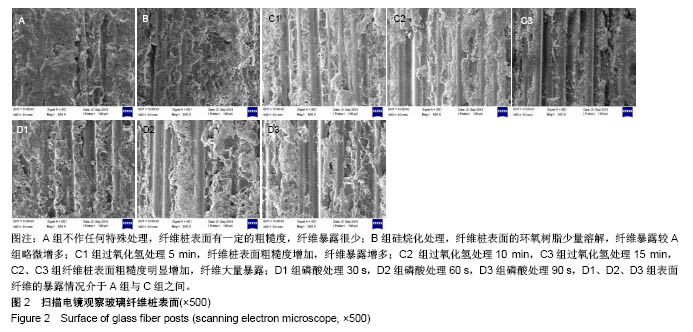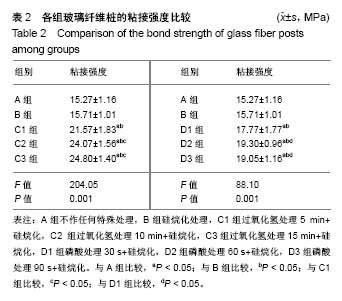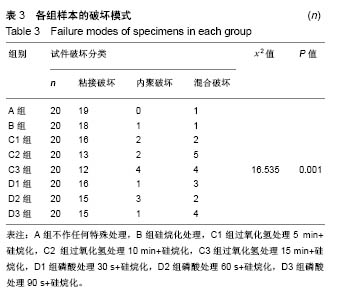中国组织工程研究 ›› 2019, Vol. 23 ›› Issue (18): 2852-2857.doi: 10.3969/j.issn.2095-4344.1734
• 组织工程口腔材料 tissue-engineered oral materials • 上一篇 下一篇
表面处理试剂及处理时间对玻璃纤维桩与树脂粘接强度的影响
周 晗,惠 敏,苗德田,王 乐,董西玲,张晓明
- 滨州医学院附属医院,山东省滨州市 256603
Effect of surface treatment reagents and treatment time on bond strength of glass fiber posts to resin cement
Zhou Han, Hui Min, Miao Detian, Wang Le, Dong Xiling, Zhang Xiaoming
- Binzhou Medical University Hospital, Binzhou 256603, Shandong Province, China
摘要:
文章快速阅读:
.jpg)
文题释义:
表面处理:是在基体材料表面上人工形成一层,与基体机械、物理和化学性能不同表层的工艺方法,表面处理的目的是满足产品的耐蚀性、耐磨性、装饰或其他特种功能要求,常见的表面处理方法有化学处理、机械打磨、喷涂表面和表面热处理等。
粘接强度:是指单位粘接面上承受的粘接力,粘接强度主要包括胶层的内聚强度和胶层与被粘面间的粘接强度。粘接强度的大小与胶黏剂的组成、黏料的结构与性质、被黏物的性能与表面状况及使用时操作方式等因素有关。
摘要
背景:目前临床上使用的对玻璃纤维桩进行表面处理的化学试剂,其处理时间尚无统一标准,因此探讨玻璃纤维桩表面处理试剂处理时间对纤维桩与树脂水门汀之间粘接强度的影响具有重要意义。
目的:评价2种化学试剂对玻璃纤维桩进行不同时间的表面预处理后,对玻璃纤维桩与树脂水门汀粘接强度的影响。
方法:将48根玻璃纤维桩随机分成 8 组,每组6根:A组不作任何特殊处理;B组硅烷化处理1 min;C1组体积分数30%H2O2表面处理5 min后硅烷化处理1 min;C2组体积分数30%H2O2表面处理10 min后硅烷化处理1 min;C3组体积分数30%H2O2表面处理15 min后硅烷化处理1 min;D1组35%磷酸表面处理30 s后硅烷化处理1 min;D2组35%磷酸表面处理60 s后硅烷化处理1 min;D3组35%磷酸表面处理90 s后硅烷化处理1 min;扫描电镜观察处理后玻璃纤维桩的表面形态。将玻璃纤维桩与树脂水门汀粘接,制作成圆柱形树脂块并切割成薄片样本,使用万能试验机对薄片进行微推出实验,使用体视显微镜观察薄片试件破坏模式。
结果与结论:①扫描电镜:经H2O2与磷酸处理后,玻璃纤维桩表面有不同程度的基质溶解和纤维束暴露,但纤维束完整性均未被破坏;②微推出实验:粘接强度排序为:C3组>C2组>C1组>D2组>D3组>D1组>B组>A组,除A组与B组、C2组与C3组、D2组与D3组粘接强度比较无差异外,其余组间两两比较差异均有显著性意义(P < 0.05);③体视显微镜:A、B组的破坏模式几乎全部为粘接破坏;其余6组的破坏模式虽然以粘接破坏为主,但内聚破坏和混合破坏数量增多,破坏模式逐渐由粘接破坏向内聚破坏和混合破坏转变;④结果表明:体积分数30%过氧化氢溶液的最佳处理时间为10 min,35%磷酸处理的最佳处理时间为60 s,体积分数30%过氧化氢溶液处理纤维桩表面10 min具有较大的临床应用价值。
中图分类号:



.jpg)
.jpg)

.jpg)